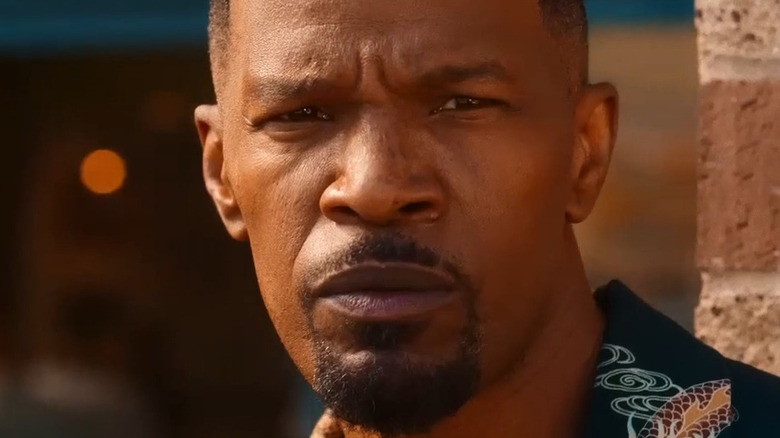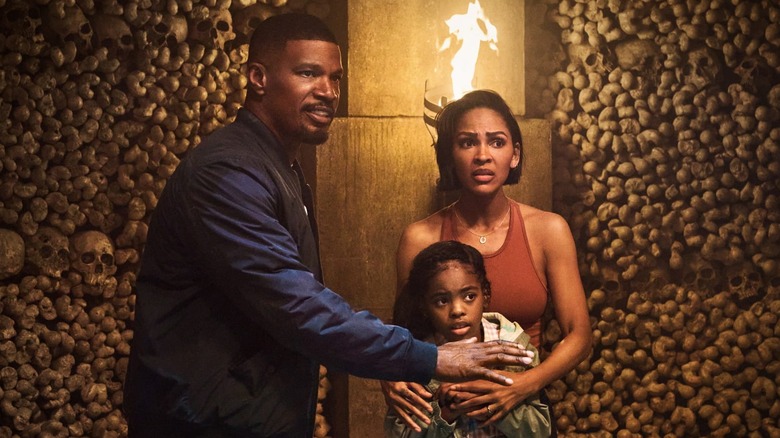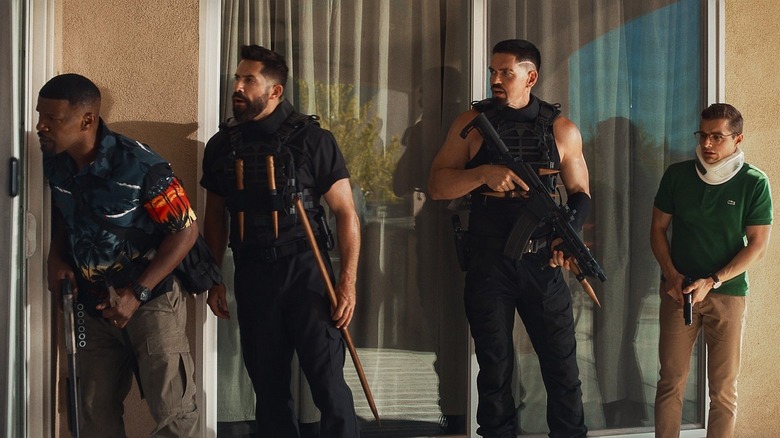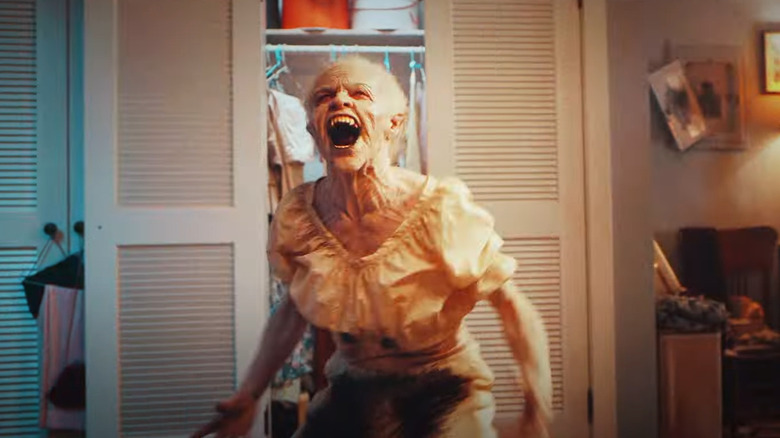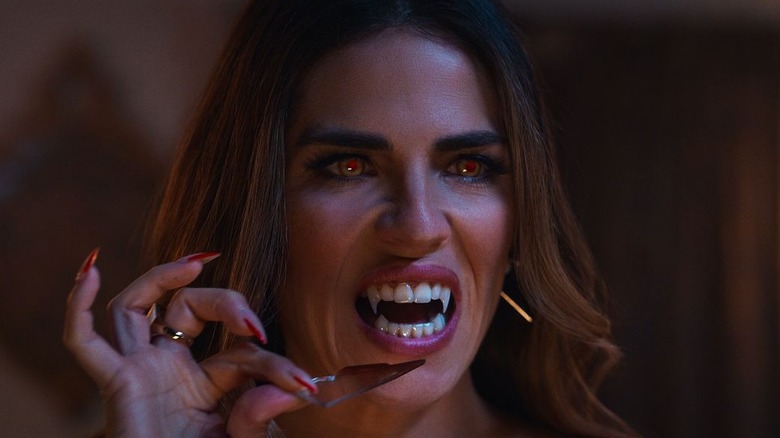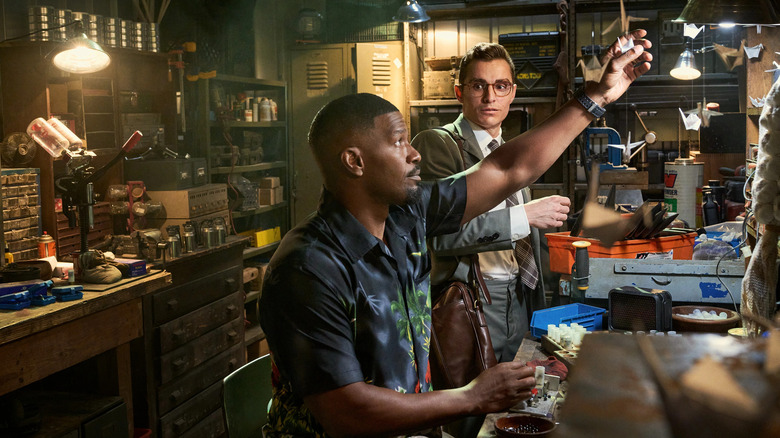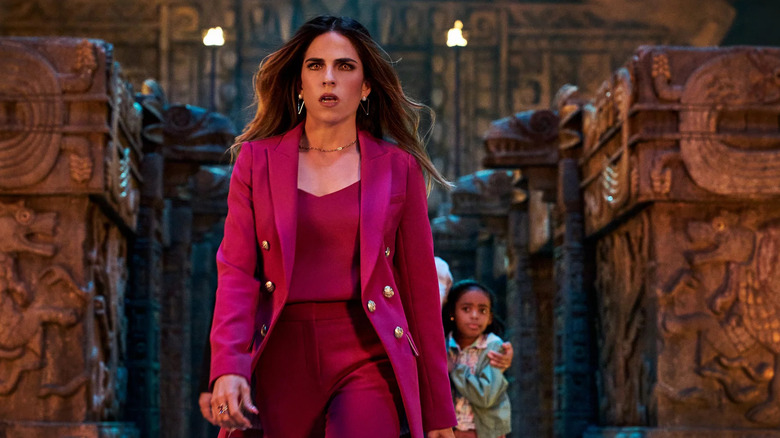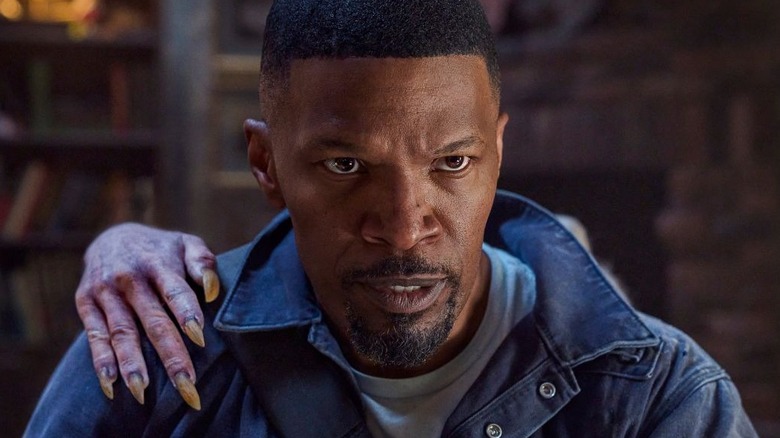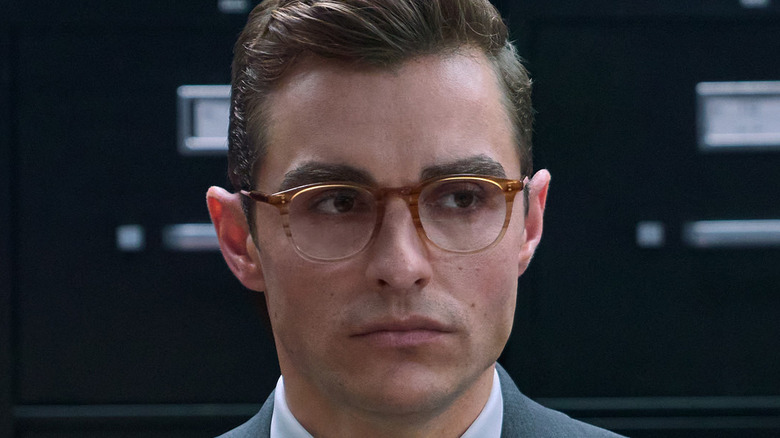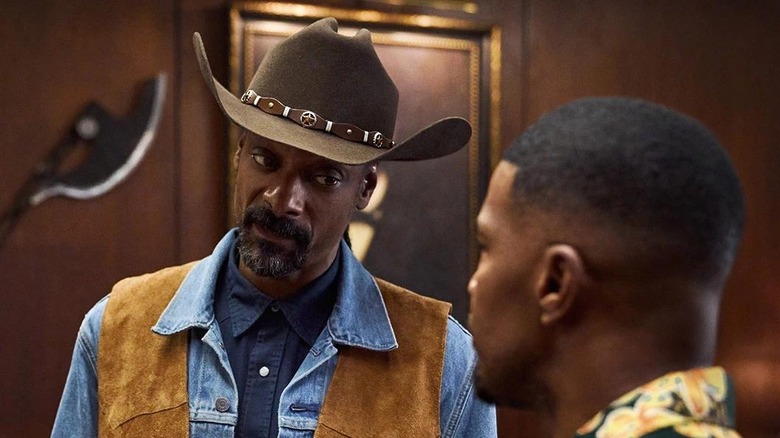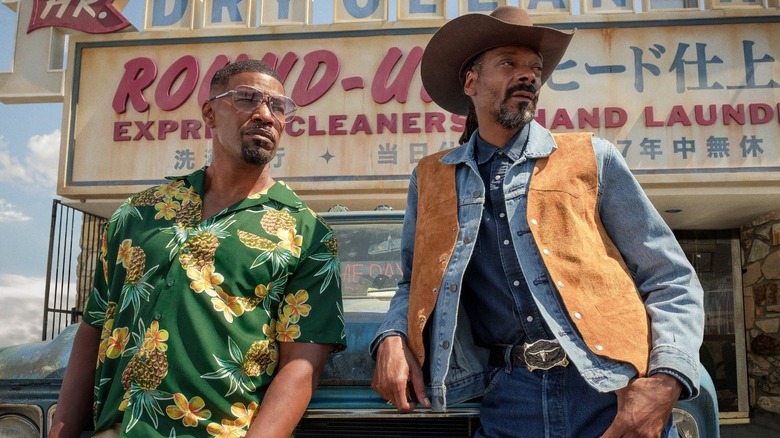Small Details You Missed In Day Shift
The modern-day renaissance in vampire movies and TV continues its supernatural flight with "Day Shift," a Netflix original movie that blends action and comedy into one solid, entertaining package. Led by Jamie Foxx and Dave Franco, the movie is not only a fun vampire-hunting romp, but it also manages to add an impressive amount of new detail to vampires and their lore. Everything from the history, diversity, and biology of the setting's various vampires is discussed by Foxx's Bud Jablonski and the other hunters, and even the fight scenes in "Day Shift" are surprisingly inventive.
Though much of the rest of "Day Shift" — like its characters, plot, and structure — are typical of the average action/comedy, the level to which it pays attention to its littlest detail is anything but, and that leads to a remarkable amount of brilliant moments that can easily be missed. Details as small as the paintings on the wall of a vampire's home or the clothes they wear reveal a lot about the movie's setting and history if you manage to catch them. To shed some vampire-slaying sunlight on the movie's more hidden aspects, here are the small details you missed in "Day Shift."
You can spot vampires by their homes
If you paid close enough attention to the various sets in "Day Shift," you may just be rewarded with a valuable secret: you can spot vampires before they're revealed just by the homes they keep. The first example comes in the movie's very first scene in which Jablonski breaks into a seemingly normal home, soon after revealed as the den of one terrifying, ancient vampire. But for those who looked closely, the old monstress' presence was hinted at the second Jablonski stepped through the door.
Immediately after entering, Jablonski's breath becomes visible — this house is freezing cold, so it clearly isn't meant to house humans. Then the house's décor is revealed, providing another major clue: The house's many decorations are almost exclusively antiques. Because vampires can potentially live for centuries, the objects they keep to honor memories are equivalently old. On top of that, vampires don't require many of the modern comforts that humanity relies on, and so they simply don't buy them.
If you kept those clues in mind, then Jablonski's first visit to Heather's apartment was a more telling one. Though Heather seems innocent and sweet, she is later revealed to be a vampire, specifically one spying on Jablonski. And though she's not quite centuries old, she is older than she looks, which explains why she kept — as Jablonski himself put it upon first entering — a "retro vibe" throughout.
Gun names reveal a lot
There are many different vampire hunters in "Day Shift," and what they choose to name their weapons — or not name them all — says a lot about their individual personalities. The first weapon whose name we learn is Snake Eyes, the pistol that Jablonski keeps as a sidearm. The hunter also keeps matching fuzzy dice in his truck and even listens to dice-rolling-themed music, like "Grinding All My Life" by Nipsey Hussle. The dice are symbolic of Jablonski's constant risk-taking, as he gambles with his life against vampires and gambles with his relationship through his behavior. His habitual risk-taking is what caused him to be expelled from the vampire hunting union, setting up the whole movie.
The other weapon with an obvious name is Big Bertha, the giant machine gun wielded by Snoop Dogg's hunter character, Big John. The massive gun requires its own dedicated backpack just to hold its ammo. Just as Big Bertha is John's literal big gun, John is the vampire hunters union's metaphorical big gun. Big Bertha is big, bold, and commands attention, and in all those ways is symbolic of John himself.
Likewise, the weapons that remain nameless tell us a lot about their wielders. When we meet the feared, revered hunters the Nazarian brothers, they each possess a number of weapons, and neither brother names any of them. Like the weapons, the brothers themselves are all business and essentially indistinguishable from each other.
Classic vampire lore
One of the most impressive features of "Day Shift" is just how thoroughly it develops and explains its vampire lore. Between the hunters and the vampires themselves, the characters flesh out an unusual amount of detail regarding how and why vampires work the way they do. Though some of the vampiric powers and weaknesses are new to "Day Shift" (at least in their particular combination and unique variations), many are nods to older, established vampire lore, and prove that the movie's creative team did their homework.
The vampiric trait most central to the main story of "Day Shift" is their vulnerability to sunlight, which the enterprising, contemporary vampire Audrey hopes to solve with specially-formulated sunscreen — as well as buying up every house in Los Angeles to provide shelter. That aversion to the sun's rays dates back to 1922, first appearing in "Nosferatu." Other classic traits like not casting a reflection, supernatural charm, a paradoxical excess of either extreme beauty or extreme hideousness, and of course drinking human blood, all date back to either Gothic fiction of the 18th and 19th centuries or even further to antiquity. The same is true for their accelerated healing abilities and thus, the need for special methods of slaying them: stake to the heart, cut off the head, and burn the corpse.
Brand new vampire lore
Despite the myriad ways in which "Day Shift" honors its predecessors by maintaining their established mythologies, it also finds a few clever ways to reinterpret facets of the lore — and even invent entirely new ones. Some of the best involve chemistry, as Jablonski, somewhat of a self-made expert on the subject, explains throughout. For one, wooden stakes are not effective against vampires for any magical reason — the monsters are simply allergic to wood. Jablonski has evidently even tested multiple types of wood for the maximum allergic response, which he uses, in his words, "not just any wood. It's mpingo wood, the strongest African hardwood. Not that Ikea s**t."
Another new take on the established mythos is the five species of vampires and in particular the unique set of fangs that each species possesses. In the world of "Day Shift," all vampires can be sorted into five categories: Juvenile, Spider, Eastern, Southern, and Uber — with the added descriptor of "elder" applied to any that live beyond a century or so. Each of the five species has its own unique fangs, like for example the Eastern vampires, who sport two central fangs in the style of "Nosferatu." Others are placed to the sides of the mouth, some feature cruel-looking serrations, and more.
And if there's one most obvious new twist the movie puts on vampire lore, it's the literal twisting that vampires do. Cleverly, "Day Shift" uses vampires' canonical ability to heal quickly to its fullest extent, letting vampires purposefully break and re-heal themselves as needed, essentially gaining the ability to morph.
The origins of vampires explained
One of the most interesting parts of "Day Shift" for the more fastidious lore-hunters (which, since you're reading this, is you) is the very bold, definitive statement it makes about vampire origins and evolution — and especially how it does so with just a few, seemingly trivial lines. The most common way that "Day Shift" redefines vampire origins, and yet the subtlest, is by always referring to the different types of vampires as species. Although it's true that the term can refer to any subset of a larger group, the word is by far most commonly used to denote biological species, meaning that in "Day Shift," vampires are natural animals, the same as humans.
But "Day Shift" goes further to make its point clear. When Audrey interrogates Peter Stormare's character Troy, Audrey mentions that "There was a time when you humans, you worshiped us as gods." The key word there is "as," which would be an odd choice of phrase if vampires were indeed supernatural, super-powered entities. And then Troy drives in the final nail in the vampires' coffin by revealing that "You're a big mistake. You're a genetic mutation that would've died out if there hasn't been a stinking hole for y'all to crawl into."
If vampires are indeed a genetic variant of humans, then in evolutionary biology terms, they are humans — just as we didn't stop being apes and primates when we developed our unique quirks. And even further: if one mutation created vampires, what other mutations might have occurred in the world of "Day Shift?"
Vampires in history
Although the vampire species in "Day Shift" are evidently natural, biological creatures, mere genetic variants of humans, that didn't stop ancient humanity from believing they were gods — and honoring them with gifts befitting their divine status. In addition to Audrey's passing remark that humans used to worship vampires as if they were gods, the majority of the movie's third act takes place in one giant ancient human temple, erected to honor vampires.
The temple is a massive stone structure, apparently hidden somewhere below Los Angeles, and seems to suggest hundreds, if not thousands, of years in which humanity worshiped vampires. Some portions of the temple were clearly used as a mausoleum, with countless skulls and other human bones stacked from floor to ceiling, reminiscent of European counterparts like the Catacombs of Paris.
Other portions of the temple seem decidedly Aztec, with frequent depictions of Quetzalcóatl, their feathered serpent-god. Still, other portions seem even older, as the huge stone heads they contain seem to imply that the temple dates back at least to the Olmec civilization, thousands of years before the present day. That begs multiple questions, including how long have vampires existed, to what extent have they impacted the course of human society, and what fraction of the global population do they make up?
The clothes make the man (and the vamp)
So many of the small details in "Day Shift" that make the biggest difference come in the form of the characters' clothes and accessories. From start to finish, the movie does a truly stellar job of choosing, changing, and keeping track of the many outfits and accessories it contains, always shooting for the most logical, story-driven options. The most obvious example is the thick layers that vampires wear when out in sunlight (before Audrey's new sunscreen spreads), but a less obvious example is what they wear when they're safely in the shade. Vampires clearly wear whatever they feel like by default, whether that be a business suit, tuxedo, or Victorian-era pantaloons. That stylistic freedom makes sense, given that vampires are immune to the effects of heat and cold.
Conversely, humans almost always wear functional clothing, and in the rare case that they don't, they're called out. When he's hunting, Jablonski always wears either a disguise, like his pool-cleaning uniform or a functional outfit, like his trademark combo of cargo pants and light, inconspicuous top. Likewise, the Nazarian brothers are decked out in combat gear, head to toe. The only human who forgets this is Franco's novice hunter, Seth, who comes to his first hunt in a full suit. Jablonski promptly gives him a (har har) dressing down, and from then on, his outfits are purely functional.
The vampire hunters union's secrets
A huge source of small details in "Day Shift" comes from the vampire hunters union, an elaborate, extensive organization that puts a new, more standardized twist on vampire hunting. In addition to helping to equip, coordinate, and police the hunters, the group also runs an international market that deals in vampire fangs. When John shows Jablonski the union headquarters, we not only see a finance department that throws huge wads of cash around as if it were nothing, but we also see that similar transactions are taking place in Hong Kong, Paris, Berlin, and a handful of other major world capitals.
From just these small details, we learn that vampire hunting is a major global industry, and we're also forced to ask the question: What is the significance of the fangs? Black-market traders like Troy explain in depth the variations in fangs between species and ages, along with a corresponding variation in value, yet never explains why the value exists. They may be mere trophies or they may have some practical use, like perhaps a unique chemical composition.
As if a global fang market wasn't strange enough, the union also has some weird quirks at the local level. When Seth finishes his transformation into an Uber vampire, he insists that he can continue to work at the union as if nothing had changed. Can union members not spot vampires, do they accept benevolent vampires, or is the whole place already run by vampires? Either way, the little details inherent in the union's operation open the world of "Day Shift" up exponentially wider.
Snoop Dogg might be a vampire
During the film's climax, John is gravely injured, decides to sacrifice himself to save Jablonski and his family, and yet emerges from the literal ashes seemingly unscathed. The exact details of how might just cause you to question whether or not John is even human anymore.
While fighting through the underground mausoleum, John is bitten in the neck by a vampire. Despite assuring Jablonski that the wound is nothing serious, John nonetheless staggers from it, acts woozy, and decides — almost certainly thinking he's about to die — to sacrifice himself for Jablonski. He ignites his bomb-vest, seemingly destroying a gang of vampires and himself in the process. And yet, in the very last scene in "Day Shift," John emerges from a manhole, alive and very clearly not blown up. Full of energy and no longer woozy, he wraps the film up with the line "That's what I love about LA. All the d*** vampires!"
Obviously, John surviving a bomb strapped to his chest is suspicious, especially so given the vampire bite he received before it happened. If there was one clue that might confirm our suspicions, either way, it would have been in the last smile John flashes at the L.A. night. Sadly, he doesn't quite bear enough of his teeth for us to confirm the presence or absence of fangs.
Setting up a sequel
For dozens of reasons, "Day Shift" is positively begging for a sequel. The movie goes to great lengths to establish its wider world and the potential adventures therein. It hints at a complex history between vampires and humans, sets up an entire union of vampire hunters that we barely meet, introduces fun characters like the Nazarian brothers for seemingly no reason, and even shows the beginnings of a vampire civil war — like when John and Jablonski discover that Audrey keeps stores of anti-vampire bullets for some unknown purpose. All these odd and unexplainable moments would be unnecessary fluff if the film's writers didn't have a franchise in mind.
The fate of the main cast also supports a potential sequel, as every one of the main characters survives. Even John, who had seemingly died, ends the film alive and well. And beyond even that reversal of fate, Seth ends the movie having just become an Uber vampire, primed to begin that fish-out-of-water journey alongside his new partner, Jablonski.
More than all of these sequel teases, though, the biggest of them all has to be the frequent mention of El Jefe. According to Seth, El Jefe is a "legendary 700-year-old European vampire" who potentially runs the L.A. drug business. John, too, mentions El Jefe as beyond the scope of Jablonski's whole adventure, practically screaming for the studio to release a sequel to "Day Shift."
